engine PORSCHE 911 TURBO 2004 4.G Information Manual
[x] Cancel search | Manufacturer: PORSCHE, Model Year: 2004, Model line: 911 TURBO, Model: PORSCHE 911 TURBO 2004 4.GPages: 61, PDF Size: 2.14 MB
Page 16 of 61
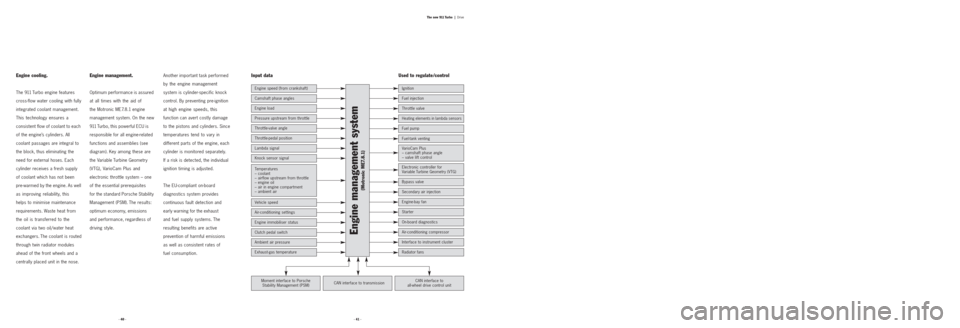
Engine cooling.
The 911 Turbo engine features
cross-flow water cooling with fully
integrated coolant management.
This technology ensures a
consistent flow of coolant to each
of the engine’s cylinders. All
coolant passages are integral to
the block, thus eliminating the
need for external hoses. Each
cylinder receives a fresh supply
of coolant which has not been
pre-warmed by the engine. As well
as improving reliability, this
helps to minimise maintenance
requirements. Waste heat from
the oil is transferred to the
coolant via two oil/water heat
exchangers. The coolant is routed
through twin radiator modules
ahead of the front wheels and a
centrally placed unit in the nose.
Engine management.
Optimum performance is assured
at all times with the aid of
the Motronic ME7.8.1 engine
management system. On the new
911 Turbo, this powerful ECU is
responsible for all engine-related
functions and assemblies (see
diagram). Key among these are
the Variable Turbine Geometry
(VTG), VarioCam Plus and
electronic throttle system – one
of the essential prerequisites
for the standard Porsche Stability
Management (PSM). The results:
optimum economy, emissions
and performance, regardless of
driving style.Another important task performed
by the engine management
system is cylinder-specific knock
control. By preventing pre-ignition
at high engine speeds, this
function can avert costly damage
to the pistons and cylinders. Since
temperatures tend to vary in
different parts of the engine, each
cylinder is monitored separately.
If a risk is detected, the individual
ignition timing is adjusted.
The EU-compliant on-board
diagnostics system provides
continuous fault detection and
early warning for the exhaust
and fuel supply systems. The
resulting benefits are active
prevention of harmful emissions
as well as consistent rates of
fuel consumption.
· 40 ·· 41 ·The new 911 Turbo |
Drive
Input data Used to regulate /control
Engine management system
(Motronic ME7.8.1)
Engine load
Pressure upstream from throttle
Throttle-valve angle
Engine speed (from crankshaft)
Camshaft phase angles
Throttle-pedal position
Lambda signal
Knock sensor signal
Ignition
Fuel injection
Throttle valve
Heating elements in lambda sensors
Fuel pump
Fuel-tank venting
CAN interface to
all-wheel drive control unit CAN interface to transmissionMoment interface to Porsche
Stability Management (PSM)
VarioCam Plus
– camshaft phase angle
– valve lift control
Electronic controller for
Variable Turbine Geometry (VTG)
Bypass valve
Secondary air injection
Engine-bay fan
Starter
On-board diagnostics
Air-conditioning compressor
Interface to instrument cluster
Radiator fans
Vehicle speed
Air-conditioning settings
Engine immobiliser status
Clutch pedal switch
Ambient air pressure
Temperatures
– coolant
– airflow upstream from throttle
– engine oil
– air in engine compartment
– ambient air
Exhaust-gas temperature
Page 17 of 61
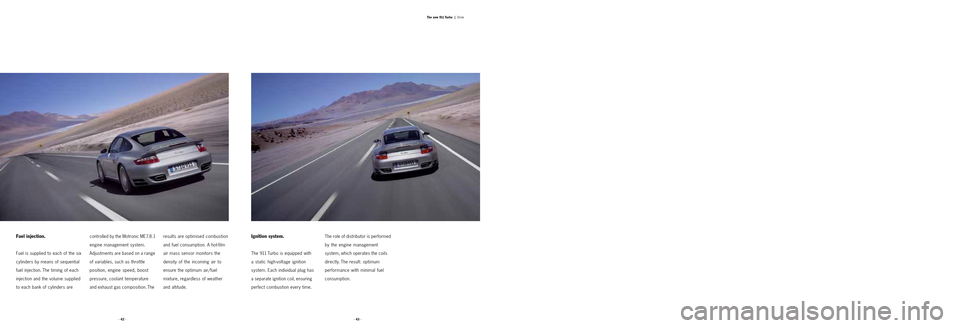
Fuel injection.
Fuel is supplied to each of the six
cylinders by means of sequential
fuel injection. The timing of each
injection and the volume supplied
to each bank of cylinders are
controlled by the Motronic ME7.8.1
engine management system.
Adjustments are based on a range
of variables, such as throttle
position, engine speed, boost
pressure, coolant temperature
and exhaust gas composition. Theresults are optimised combustion
and fuel consumption. A hot-film
air mass sensor monitors the
density of the incoming air to
ensure the optimum air/fuel
mixture, regardless of weather
and altitude.
Ignition system.
The 911 Turbo is equipped with
a static high-voltage ignition
system. Each individual plug has
a separate ignition coil, ensuring
perfect combustion every time.
The role of distributor is performed
by the engine management
system, which operates the coils
directly. The result: optimum
performance with minimal fuel
consumption.
· 42 ·· 43 ·The new 911 Turbo |
Drive
Page 18 of 61

are reduced thanks to lengthy
replacement intervals for both
the engine oil (18,000 miles) and
air filter unit (36,000 miles). The
spark plugs require changing after
36,000 miles or a maximum of
every four years. The generator,
power-steering pump and air-
conditioning compressor are all
driven by a single self-adjusting
belt with a service life of 54,000
miles. The hydraulic tappets
provide automatic adjustment of
all valve clearances, while the
drive chains on the camshafts
and auxiliary shafts will also last
the life of the car.
Basic servicing is required after
18,000 miles or a maximum of
two years on the road. The first
major service is due at 36,000
miles or every four years at the
latest. The results: lower running
costs and virtually uninterrupted
enjoyment from your Porsche.
Exhaust system.
The exhaust system on the
911 Turbo is made from highly
durable stainless steel. The
system consists of two separate
tracts, one for each bank of
cylinders. The catalytic converters
are extremely heat-resistant,
yet quick to reach temperature
(and thus optimum performance)
when the engine is started
from cold.Twin lambda sensors in each of
the exhausts enable continuous
monitoring of the combustion
process. An additional pair of
sensors* is used to measure
the efficiency of the catalytic
converters.
Servicing.
Another pleasant surprise on the
new 911 Turbo is the standard
service schedule. Running costs
The new six-speed manual
gearbox in the 911 Turbo is
specifically adapted to the car’s
high levels of engine torque.
Designed primarily for sports
driving, one immediate
characteristic is the perfectly
judged spread betweensuccessive ratios as you upshift
through the gears. The gearshift
throw is short and precise,
with only minimal force required.
Thanks to a dual-mass flywheel,
this uncompromising setup means
there’s never any compromise
in comfort. The linkage provides
a direct connection with the
gearbox while insulating
the lever from engine vibration.
One final detail – the new gear
lever design – is exclusive to
the 911 Turbo.
· 44 ·· 45 ·The new 911 Turbo |
Drive
Six-speed manual gearbox.
Superlative power requires equal precision.
Gear lever exclusive to 911 Turbo* Not in markets with leaded fuel.
Page 19 of 61
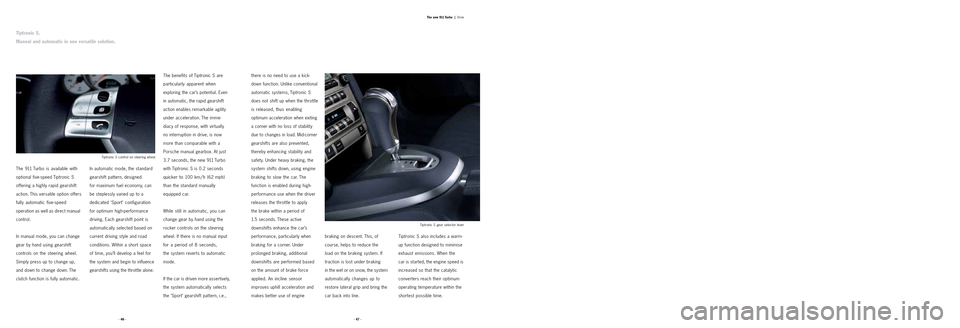
Tiptronic S also includes a warm-
up function designed to minimise
exhaust emissions. When the
car is started, the engine speed is
increased so that the catalytic
converters reach their optimum
operating temperature within the
shortest possible time. braking on descent. This, of
course, helps to reduce the
load on the braking system. If
traction is lost under braking
in the wet or on snow, the system
automatically changes up to
restore lateral grip and bring the
car back into line. there is no need to use a kick-
down function. Unlike conventional
automatic systems, Tiptronic S
does not shift up when the throttle
is released, thus enabling
optimum acceleration when exiting
a corner with no loss of stability
due to changes in load. Mid-corner
gearshifts are also prevented,
thereby enhancing stability and
safety. Under heavy braking, the
system shifts down, using engine
braking to slow the car. The
function is enabled during high-
performance use when the driver
releases the throttle to apply
the brake within a period of
1.5 seconds. These active
downshifts enhance the car’s
performance, particularly when
braking for a corner. Under
prolonged braking, additional
downshifts are performed based
on the amount of brake force
applied. An incline sensor
improves uphill acceleration and
makes better use of engine
The 911 Turbo is available with
optional five-speed Tiptronic S
offering a highly rapid gearshift
action. This versatile option offers
fully automatic five-speed
operation as well as direct manual
control.
In manual mode, you can change
gear by hand using gearshift
controls on the steering wheel.
Simply press up to change up,
and down to change down. The
clutch function is fully automatic.In automatic mode, the standard
gearshift pattern, designed
for maximum fuel economy, can
be steplessly varied up to a
dedicated ‘Sport’ configuration
for optimum high-performance
driving. Each gearshift point is
automatically selected based on
current driving style and road
conditions. Within a short space
of time, you’ll develop a feel for
the system and begin to influence
gearshifts using the throttle alone.
The benefits of Tiptronic S are
particularly apparent when
exploring the car’s potential. Even
in automatic, the rapid gearshift
action enables remarkable agility
under acceleration. The imme-
diacy of response, with virtually
no interruption in drive, is now
more than comparable with a
Porsche manual gearbox. At just
3.7 seconds, the new 911 Turbo
with Tiptronic S is 0.2 seconds
quicker to 100 km / h (62 mph)
than the standard manually
equipped car.
While still in automatic, you can
change gear by hand using the
rocker controls on the steering
wheel. If there is no manual input
for a period of 8 seconds,
the system reverts to automatic
mode.
If the car is driven more assertively,
the system automatically selects
the ‘Sport’ gearshift pattern, i.e.,
· 46 ·· 47 ·The new 911 Turbo |
Drive
Tiptronic S gear selector lever Tiptronic S control on steering wheel
Tiptronic S.
Manual and automatic in one versatile solution.
Page 20 of 61
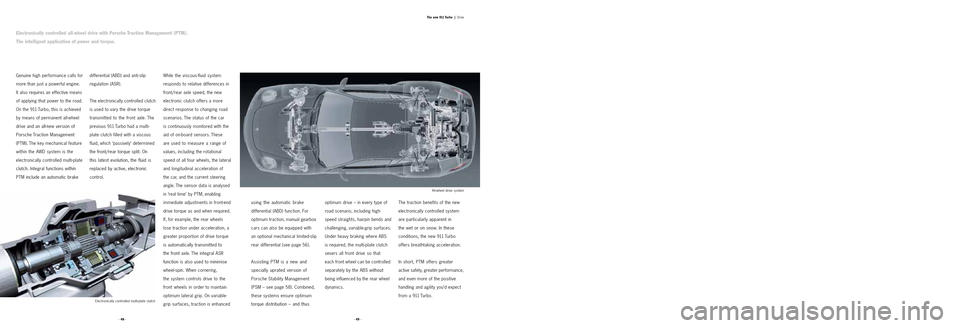
using the automatic brake
differential (ABD) function. For
optimum traction, manual gearbox
cars can also be equipped with
an optional mechanical limited-slip
rear differential (see page 56).
Assisting PTM is a new and
specially uprated version of
Porsche Stability Management
(PSM – see page 58). Combined,
these systems ensure optimum
torque distribution – and thus
optimum drive – in every type of
road scenario, including high-
speed straights, hairpin bends and
challenging, variable-grip surfaces.
Under heavy braking where ABS
is required, the multi-plate clutch
severs all front drive so that
each front wheel can be controlled
separately
by the ABS without
being influenced by the rear wheel
dynamics.
The traction benefits of the new
electronically controlled system
are particularly apparent in
the wet or on snow. In these
conditions, the new 911 Turbo
offers breathtaking acceleration.
In short, PTM offers greater
active safety, greater performance,
and even more of the positive
handling and agility you’d expect
from a 911 Turbo.
· 49 ·The new 911 Turbo |
Drive
differential (ABD) and anti-slip
regulation (ASR).
The electronically controlled clutch
is used to vary the drive torque
transmitted to the front axle. The
previous 911 Turbo had a multi-
plate clutch filled with a viscous
fluid, which ‘passively’ determined
the front/rear torque split. On
this latest evolution, the fluid is
replaced by active, electronic
control.While the viscous-fluid system
responds to relative differences in
front/rear axle speed, the new
electronic clutch offers a more
direct response to changing road
scenarios. The status of the car
is continuously monitored with the
aid of on-board sensors. These
are used to measure a range of
values, including the rotational
speed of all four wheels, the lateral
and longitudinal acceleration of
the car, and the current steering
angle. The sensor data is analysed
in ‘real time’ by PTM, enabling
immediate adjustments in front-end
drive torque as and when required.
If, for example, the rear wheels
lose traction under acceleration, a
greater proportion of drive torque
is automatically transmitted to
the front axle. The integral ASR
function is also used to minimise
wheel-spin. When
cornering,
the system controls drive to the
front wheels in order to maintain
optimum lateral grip. On variable-
grip surfaces, traction is enhanced
· 48 · Electronically controlled multi-plate clutchAll-wheel drive system
Genuine high performance calls for
more than just a powerful engine.
It also requires an effective means
of applying that power to the road.
On the 911 Turbo, this is achieved
by means of permanent all-wheel
drive and an all-new version of
Porsche Traction Management
(PTM). The key mechanical feature
within the AWD system is the
electronically controlled multi-plate
clutch. Integral functions within
PTM include an automatic brake
Electronically controlled all-wheel drive with Porsche Traction Management (PTM).
The intelligent application of power and torque.
Page 26 of 61
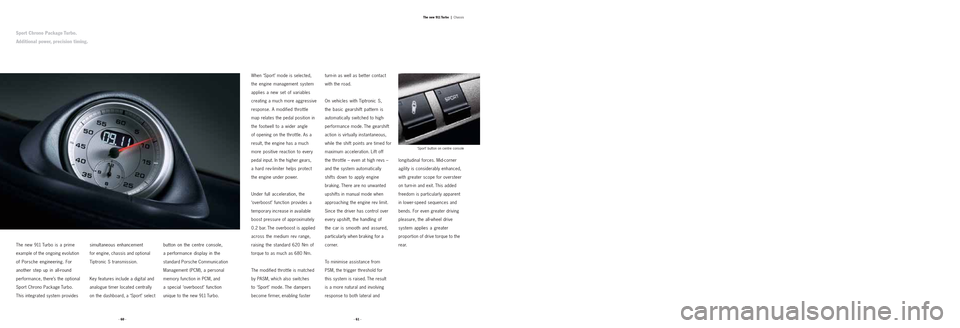
The new 911 Turbo is a prime
example of the ongoing evolution
of Porsche engineering. For
another step up in all-round
performance, there’s the optional
Sport Chrono Package Turbo.
This integrated system provides
simultaneous enhancement
for engine, chassis and optional
Tiptronic S transmission.
Key features include a digital and
analogue timer located centrally
on the dashboard, a ‘Sport’ select
button on the centre console,
a performance display in the
standard Porsche Communication
Management (PCM), a personal
memory function in PCM, and
a special ‘overboost’ function
unique to the new 911 Turbo.When ‘Sport’ mode is selected,
the engine management system
applies a new set of variables
creating a much more aggressive
response. A modified throttle
map relates the pedal position in
the footwell to a wider angle
of opening on the throttle. As a
result, the engine has a much
more positive reaction to every
pedal input. In the higher gears,
a hard rev-limiter helps protect
the engine under power.
Under full acceleration, the
‘overboost’ function provides a
temporary increase in available
boost pressure of approximately
0.2 bar. The overboost is applied
across the medium rev range,
raising the standard 620 Nm of
torque to as much as 680 Nm.
The modified throttle is matched
by PASM, which also switches
to ‘Sport’ mode. The dampers
become firmer, enabling fasterturn-in as well as better contact
with the road.
On vehicles with Tiptronic S,
the basic gearshift pattern is
automatically switched to high-
performance mode. The gearshift
action is virtually instantaneous,
while the shift points are timed for
maximum acceleration. Lift off
the throttle – even at high revs –
and the system automatically
shifts down to apply engine
braking. There are no unwanted
upshifts in manual mode when
approaching the engine rev limit.
Since the driver has control over
every upshift, the handling of
the car is smooth and assured,
particularly when braking for a
corner.
To minimise assistance from
PSM, the trigger threshold for
this system is raised. The result
is a more natural and involving
response to both lateral andlongitudinal forces. Mid-corner
agility is considerably enhanced,
with greater scope for oversteer
on turn-in and exit. This added
freedom is particularly apparent
in lower-speed sequences and
bends. For even greater driving
pleasure, the all-wheel drive
system applies a greater
proportion of drive torque to the
rear.
· 60 ·· 61 ·The new 911 Turbo |
Chassis
‘Sport’ button on centre console
Sport Chrono Package Turbo.
Additional power, precision timing.
Page 34 of 61
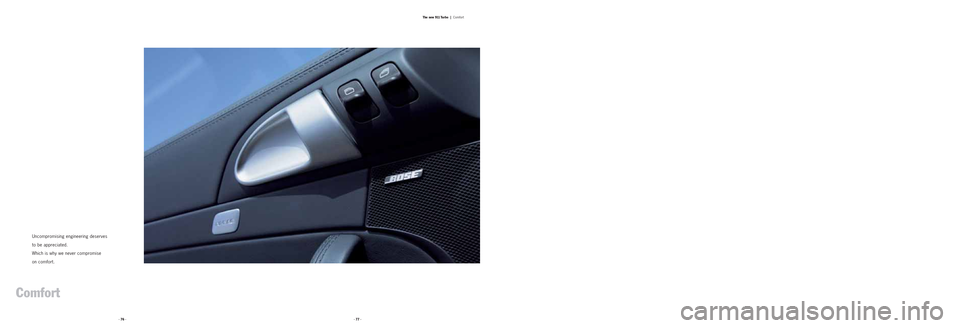
· 76 ·· 77 ·The new 911 Turbo |
Comfort
Uncompromising engineering deserves
to be appreciated.
Which is why we never compromise
on comfort.
Comfort
Page 38 of 61
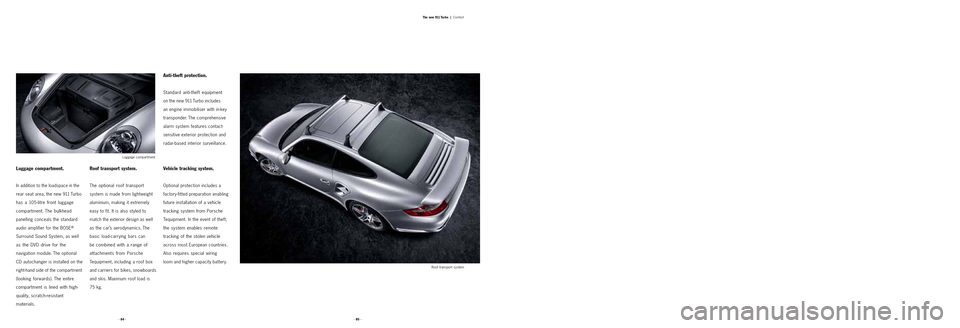
· 85 ·The new 911 Turbo |
Comfort
Luggage compartment.
In addition to the loadspace in the
rear seat area, the new 911 Turbo
has a 105-litre front luggage
compartment. The bulkhead
panelling conceals the standard
audio amplifier for the BOSE
®
Surround Sound System, as well
as the DVD drive for the
navigation module. The optional
CD autochanger is installed on the
right-hand side of the compartment
(looking forwards). The entire
compartment is lined with high-
quality, scratch-resistant
materials.
Roof transport system.
The optional roof transport
system is made from lightweight
aluminium, making it extremely
easy to fit. It is also styled to
match the exterior design as well
as the car’s aerodynamics. The
basic load-carrying bars can
be
combined with a range of
attachments from Porsche
Tequipment, including a roof box
and carriers for bikes, snowboards
and skis. Maximum roof load is
75 kg.
Anti-theft protection.
Standard anti-theft equipment
on the new 911 Turbo includes
an engine immobiliser with in-key
transponder. The comprehensive
alarm system features contact-
sensitive exterior protection and
radar-based interior surveillance.
Vehicle tracking system.
Optional protection includes a
factory-fitted preparation enabling
future installation of a vehicle
tracking system from Porsche
Tequipment. In the event of theft,
the system enables remote
tracking of the stolen vehicle
across most European countries.
Also requires special wiring
loom and higher capacity battery.
· 84 ·Luggage compartment
Roof transport system
Page 41 of 61
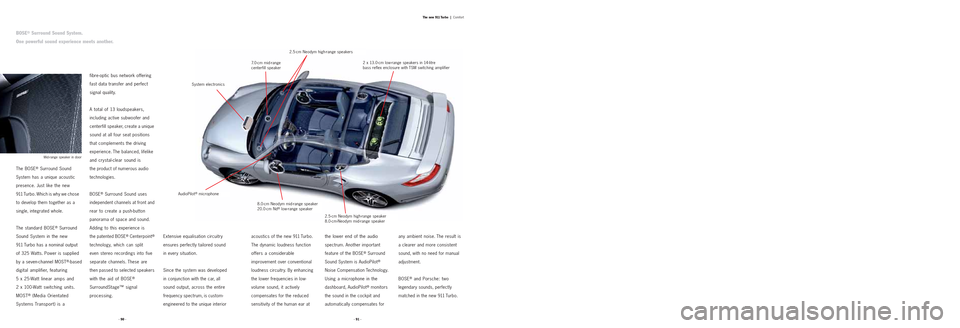
The BOSE®Surround Sound
System has a unique acoustic
presence. Just like the new
911 Turbo. Which is why we chose
to develop them together as a
single, integrated whole.
The standard BOSE®Surround
Sound System in the new
911 Turbo has a nominal output
of 325 Watts. Power is supplied
by a seven-channel MOST
®-based
digital amplifier, featuring
5 x 25-Watt linear amps and
2 x 100-Watt switching units.
MOST®(Media Orientated
Systems Transport) is a
fibre-optic bus network offering
fast data transfer and perfect
signal quality.
A total of 13 loudspeakers,
including active subwoofer and
centerfill speaker, create a unique
sound at all four seat positions
that complements the driving
experience. The balanced, lifelike
and crystal-clear sound is
the product of numerous audio
technologies.
BOSE
®Surround Sound uses
independent channels at front and
rear to create a push-button
panorama of space and sound.
Adding to this experience is
the patented BOSE
®Centerpoint®
technology, which can split
even stereo recordings into five
separate channels. These are
then passed to selected speakers
with the aid of BOSE®
SurroundStage™ signal
processing.
acoustics of the new 911 Turbo.
The dynamic loudness function
offers a considerable
improvement over conventional
loudness circuitry. By enhancing
the lower frequencies in low-
volume sound, it actively
compensates for the reduced
sensitivity of the human ear at
the lower end of the audio
spectrum. Another important
feature of the BOSE
®Surround
Sound System is AudioPilot
®
Noise Compensation Technology.
Using a microphone in the
dashboard, AudioPilot®monitors
the sound in the cockpit and
automatically compensates forany ambient noise. The result is
a clearer and more consistent
sound, with no need for manual
adjustment.
BOSE®and Porsche: two
legendary sounds, perfectly
matched in the new 911 Turbo.
· 90 ·· 91 ·The new 911 Turbo |
Comfort
2.5-cm Neodym high-range speakers
8.0-cm Neodym mid-range speaker
20.0-cm Nd®low-range speaker
2.5-cm Neodym high-range speaker
8.0-cm-Neodym mid-range speaker
System electronics
7.0-cm mid-range
centerfill speaker
AudioPilot®microphone2 x 13.0-cm low-range speakers in 14-litre
bass reflex enclosure with TSM switching amplifier
Mid-range speaker in door
BOSE®Surround Sound System.
One powerful sound experience meets another.
Extensive equalisation circuitry
ensures perfectly tailored sound
in every situation.
Since the system was developed
in conjunction with the car, all
sound output, across the entire
frequency spectrum, is custom-
engineered to the unique interior
Page 43 of 61

At Porsche, we’re exploring every
possibility to improve the environ-
mental compatibility of our cars:
modern materials, reduced fuel
consumption, cleaner emissions,
fewer pollutants and better
recyclability. This commitment is a
Porsche tradition that began in
the 1960s. With the latest evolutionof the 911 Turbo, the rewards are
even greater than ever.
Exhaust emission control.
Combine engineering expertise
with a commitment to the
environment and the resulting
benefits are twofold: exceptional
performance and lower emissions.
One of the cleanest sportscars
in the world today, the new
911 Turbo easily complies with
both the stringent Euro 4 standard
in the European Union as well
as LEV II regulations in the United
States.The technologies used to achieve
this compliance include twin
‘lambda’ or oxygen sensors for
each of the two cylinder banks.
One pair of sensors is used to
measure the levels of oxygen in
each of the twin exhaust tracts.
An additional pair of sensors –
again, one in each tract – enablethe engine management system
to monitor the efficiency of the
catalytic converters.*
Recycling.
Lightweight construction, long-
term durability, exceptional
recyclability: just three of the
techniques employed by Porsche
to improve the environmental
compatibility of our cars.
On the new 911 Turbo, we’ve
used weight-saving design and
lightweight materials to achieve
excellent fuel economy.
All materials and manufacturing
processes have been carefully
selected and specifically refined
to reduce any impact on the
environment. A prime example is
the twin exhaust system, which is
made entirely from stainless steel.
All lightweight materials are easily
recyclable, while the variety ofsynthetics has been significantly
reduced. Recycled plastics are
used in every area of the car
where our exacting specifications
allow. To simplify processing, all
materials are labelled for separate
recycling. Approximately 85 % of
today’s 911 Turbo is compatible
with current recycling techniques.
Water-based paints are used
throughout the car, thus reducing
the need for chemical solvents in
both production and subsequent
servicing. Other harmful materials
omitted from the vehicle include
asbestos, CFCs, and components
manufactured using CFCs.
The result is a car in which
environmental protection is an
integral part of the overall design.
· 94 ·· 95 ·The new 911 Turbo |
Environment
* Not in markets with leaded fuel.
The 911 Turbo is dedicated to performance.
Also with respect to the environment.